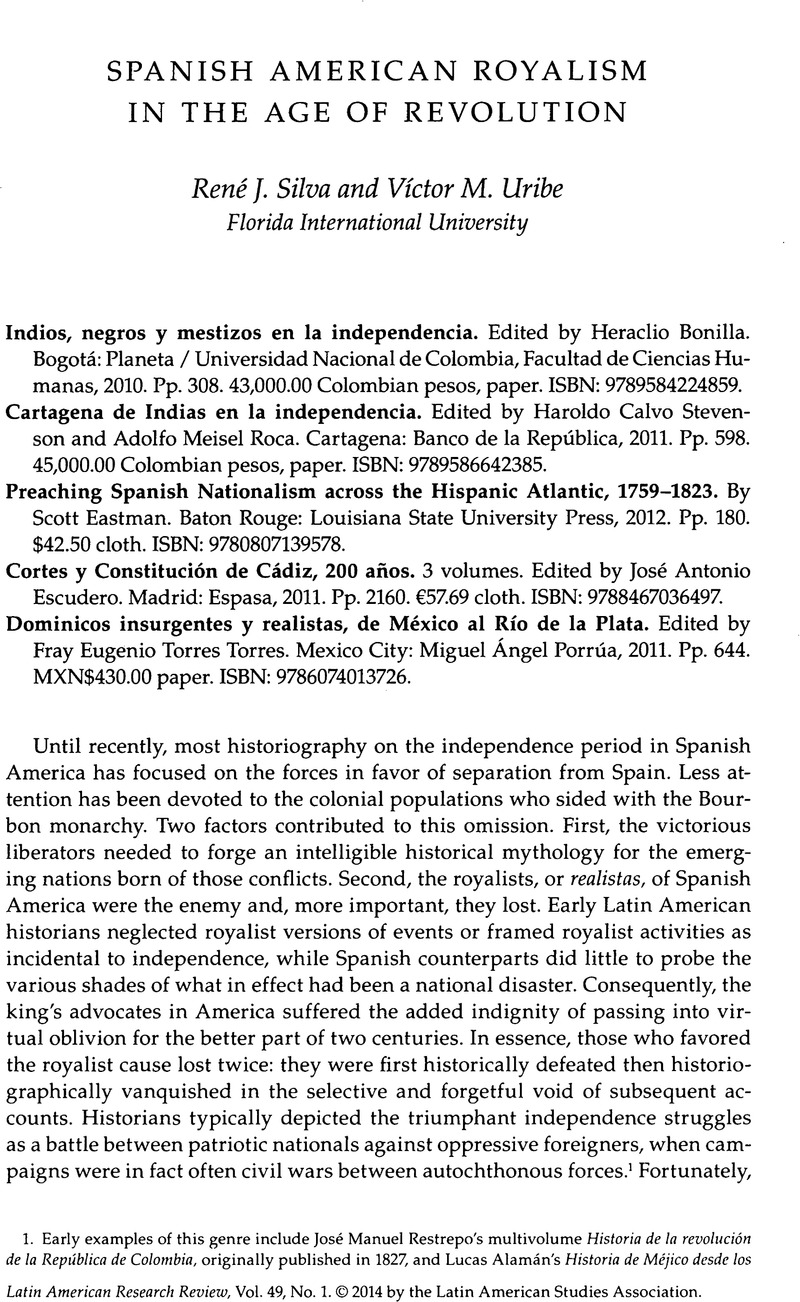Article contents
Spanish American Royalism in the Age of Revolution
Review products
Published online by Cambridge University Press: 05 September 2022
Abstract

- Type
- Review Essays
- Information
- Copyright
- Copyright © 2014 by the Latin American Studies Association
References
1. Early examples of this genre include José Manuel Restrepo's multivolume Historia de la revolución de la República de Colombia, originally published in 1827, and Lucas Alamán's Historia de Méjico desde los primeros movimientos que prepararon su independencia en el año de 1808, which first saw the light of day in 1849.
2. For an excellent account of this period, see Justo Cuño Bonito, El retorno del rey: El restablecimiento del régimen colonial en Cartagena de Indias (1815–1821) (Valencia: Universitat Jaume I, 2008).
3. In another work, this author rightly stressed the need to avoid monocausal explanations of popular royalism instead of paying close attention to the nuances of local politics. See Steinar A. Saether, Identidades e independencia en Santa Marta y Riohacha, 1750–1850 (Bogota: Instituto Colombiano de Antropología e Historia, 2005), 124–125, 132–145.
4. All translations from Spanish to English in this analysis are by the coauthors.
5. For an excellent breakdown of this process, see Roberto Breña, El primer liberalismo español y los procesos de emancipación de América, 1808–1824: Una revisión historiográfica del liberalismo hispano (Mexico City: El Colegio de México, 2006); and Breña's most recent work, El imperio de las circunstancias: Las independencias hispanoamericanas y la revolución liberal española (Mexico City: El Colegio de México; Madrid: Marcial Pons, 2013).
6. For a lucid account of this complex process, see Jaime E. Rodríguez O., The Independence of Spanish America (Cambridge: Cambridge University Press, 1998).
7. For this point, in addition to Rodríguez O., see especially François-Xavier Guerra, Modernidad e independencias: Ensayos sobre las revoluciones hispánicas (Madrid: Ediciones Encuentro, 2009).
8. Venezuela was the first to declare outright independence on July 5, 1811. See Rodríguez O., The Independence of Spanish America, 109–122.
9. The earlier Cortes discussed in Escudero, Cortes y Constitución de Cádiz, 200 años, include Castilla y León, Aragón, Valencia, Cataluña, and Navarra. See Feliciano Barrios, “Las Cortes de los reinos españoles en los siglos XVI y XVII,” vol. 1, pp. 138–155, and Pere Molas, “Las Cortes nacionales en el siglo XVIII,” vol. 1, pp. 156–172.
10. Jairo Gutiérrez Ramos, Los indios de Pasto contra la república, 1809–1824 (Bogotá: Instituto Colombiano de Antropología e Historia, 2007).
11. For the sake of simplicity in this review, we have chosen to use the terms fidelity and loyalty as synonyms, rather than employ the more intricate definitions proposed by Lovera Reyes.
12. The same could be said of Cartagena de Indias en la independencia and Dominicos insurgentes reviewed here.
13. A British American example is Janice Potter, The Liberty We Seek: Loyalist Ideology in Colonial New York and Massachusetts (Cambridge, MA: Harvard University Press, 1983).
14. To our knowledge there are no existing studies of royalists after they were defeated, with the possible exception of Harold Sims's work on the post-independence Spaniards in Mexico. See Harold Dana Sims, The Expulsion of Mexico's Spaniards, 1821–1836 (Pittsburgh, PA: University of Pittsburgh Press, 1990). For exiles from the American Revolution, see especially Maya Jasanoff, Liberty's Exiles: American Loyalists in the Revolutionary World (New York: Alfred A. Knopf, 2011).
15. For a comparable example, see Joseph S. Tiedemann, Eugene R. Fingerhut, and Robert W. Venables, eds., The Other Loyalists: Ordinary People, Royalism, and the Revolution in the Middle Colonies, 1763–1787 (Albany: State University of New York Press, 2009).
16. In this regard, see also Marcela Echeverri, “Los derechos de indios y esclavos realistas y la transformación política en Popayán, Nueva Granada (1808–1820),” Revista de Indias 69, no. 246 (2009): 45–72; and “Popular Royalists, Empire, and Politics in Southwestern New Granada, 1809–1819,” Hispanic American Historical Review 91, no. 2 (2011): 237–269.
17. See especially Robert M. Calhoon, The Loyalists in Revolutionary America, 1760–1781 (New York: Harcourt Brace Jovanovich, 1973).
18. See René J. Silva, “Loyal and Royal: A Comparative Analysis of Adherents to the Crown during the American Revolution and the Spanish American Wars of Independence,” unpublished manuscript, 2013.
- 1
- Cited by


